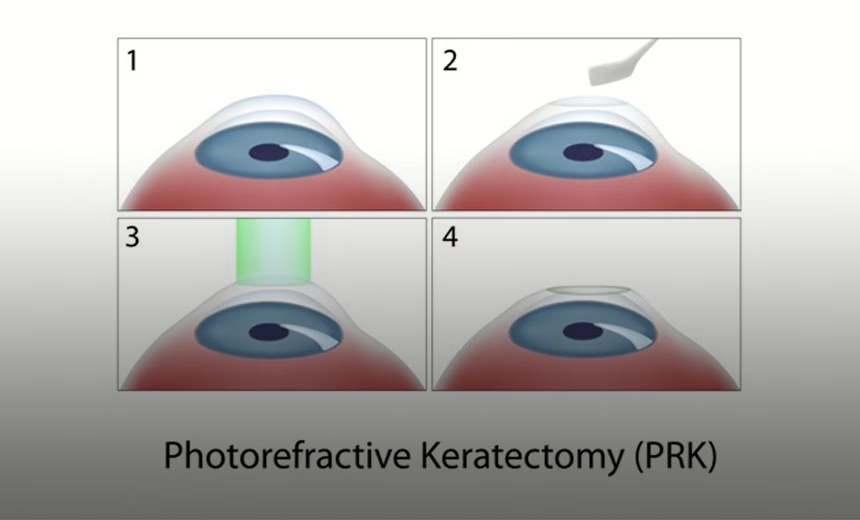Subscribe to eyeMatters periodic news
"*" indicates required fields
What is PRK (Photorefractive Keratectomy)?

If you have been considering laser eye surgery, the term ‘PRK’ would most likely have come up in your research.
Short for photorefractive keratectomy, this was the very first laser eye surgery procedure (pre LASIK and SMILE®). It was first performed by Dr Theo Seiler in 1987 but not offered commercially until the 1990s.
You may also know it as ASLA (advanced surface laser ablation).
How well does PRK work?
Any laser eye surgery procedure is designed to alter the shape of the cornea (the clear window on the front of the eye) in order to correct/improve your vision.
Historically, this form of vision correction worked very well (and continues to work well). Before LASIK and SMILE, PRK was the surgical procedure exclusively performed by ophthalmologists to correct vision abnormalities such as nearsightedness (myopia) or farsightedness (hyperopia).
How does it work?
This vision correction procedure has been performed successfully for many years now. It involves several steps.
- Removal of the top layer of the cornea. The surgeon needs access to the stromal layer of the cornea. However, there is another layer on top of it (the epithelium) which needs to be removed. This exposes the stroma, which is where the reshaping of the cornea must take place in order to correct vision.
- Reshaping. An excimer laser is used to reshape the stroma to the exact shape that is required for the particular patient. This is accurate to one micron, which is one-thousandth of a millimetre.
- Protection. After surgery, a bandage contact lens is placed on the eye, which will be removed by the surgeon in three to five days after the eye has naturally regenerated the thin layer of superficial cells.
Vision may fluctuate for several weeks after the operation, but once this settled, ASLA will provide the same visual results as LASIK and SMILE.
What are the benefits of this form of vision correction?
Whilst LASIK or SMILE are the procedures of choice for most people due to a faster and more comfortable recovery, ASLA is often recommended for people who have corneas that are not suitable for the flap that is necessary for LASIK.
There are benefits to this form of vision correction surgery, including a lower incidence of ocular dryness (dry eye) that may happen with other procedures.
Why does it take longer to recover from PRK?
One of the downsides of PRK is that it takes longer to recover than LASIK. As the initial days after the procedure can be uncomfortable, patients are provided with oral and topical pain management in order to keep them as comfortable as possible. The vision is functional within a number of days and these patients will be able to return to most normal activities within one week.
If you are considering laser eye surgery and do not qualify for LASIK, rest assured that the ASLA/PRK procedure has been performed successfully on thousands of people since 1991 in Australia.
Your laser eye surgeon will be able to assist in answering any questions you may have about your expected recovery.
SMILE® is a registered trademark of Carl Zeiss Meditec
References
- Choice. A guide to laser eye surgery. NSW, 11 August 2020. Available at https://www.choice.com.au/health-and-body/optical-and-hearing/optical/articles/guide-to-laser-eye-surgery [Accessed 6 January 2021].
- Healthdirect. Laser eye surgery. NSW, 2019. Available at https://www.healthdirect.gov.au/laser-eye-surgery [Accessed 6 January 2021].
- Lawless M. Refractive Laser Surgery: Who’s Interested Now? mivision 2019;141:33–37.
- Wilkinson JM, Cozine EW, Kahn AR. Refractive Eye Surgery: Helping Patients Make Informed Decisions About LASIK. Am Fam Physician 2017;95(10):637–44.
- Shortt AJ, Allan BDS, Evans JR. Laser‐assisted in‐situ keratomileusis (LASIK) versus photorefractive keratectomy (PRK) for myopia. Cochrane Database Syst Rev 2013; 1: CD005135.
- Somani SN, Moshirfar M, Patel BC. Photorefractive Keratectomy. In: StatPearls [Internet]. Treasure Island, FL: StatPearls Publishing; 2020.
- Doane JF, Cauble JE, Rickstrew JJ, Tuckfield JQ. Small Incision Lenticule Extraction SMILE – The Future of Refractive Surgery is Here. Mo Med 2018;115(1):82–4.
The information on this page is general in nature. All medical and surgical procedures have potential benefits and risks. Consult your ophthalmologist for specific medical advice.
Date last reviewed: 2021-06-17 | Date for next review: 2023-06-17
